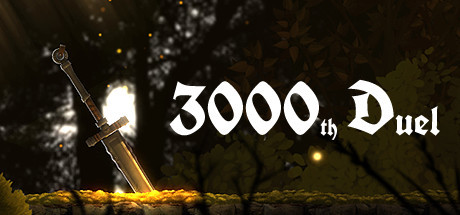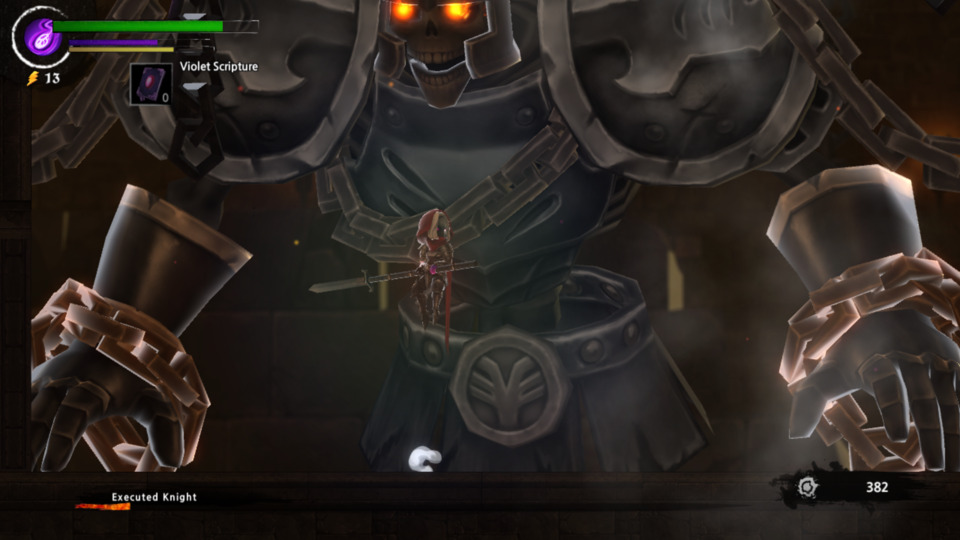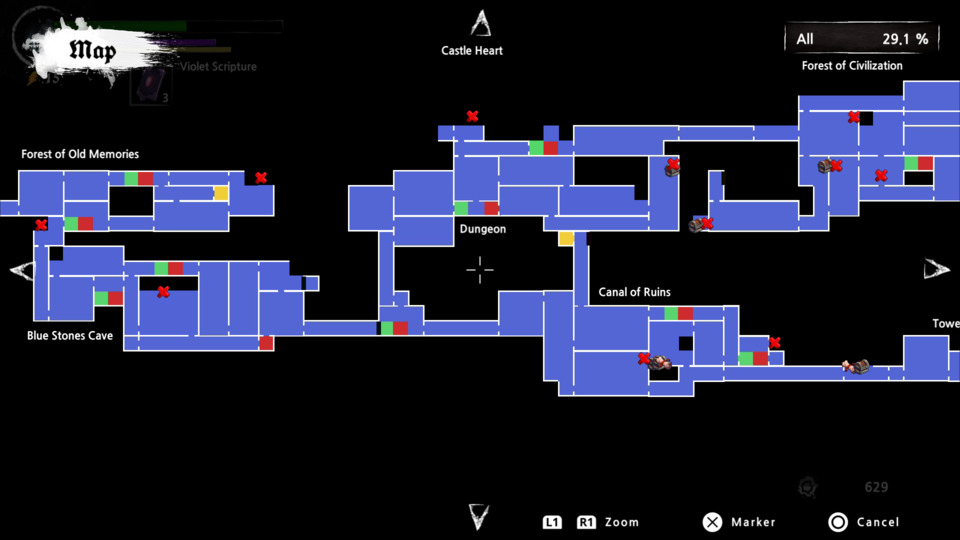
I can't speak for duels, but this is probably the 3000th explormer we've featured on Indie Game of the Week. What can I say? I have a type. 3000th Duel, from South Korean studio Neopopcorn, is an explormer-RPG hybrid that, as is almost customary at this point, has a few Soulsian affectations to its mechanics and world design. Dropped into a misty forest with amnesia and an unremovable mask, the warrior protagonist just generally mills around a large open map looking for their memories, picking up treasure and taking down corrupted undead monsters in the process. It's definitely riffing on the Dark Souls narrative blueprint of "don't show or tell, screw anyone looking for plot", hiding what lore it has in infrequent memory pick-ups (they look like floating purple orbs, as do many things in this game) and item descriptions. I'm maybe somewhere between a third and halfway through—it's a pretty dense game—and I couldn't tell you what's going on besides that something real gnarly happened to this place while you were out chilling in the woods.
Mechanically, we're looking at something similar to Salt and Sanctuary or the IGAvanias with its seamless merging of an action-platformer and a semi-complex action-RPG. You'll find the usual traversal upgrades out in the world, meted out at semi-regular intervals, but each one will also open a new section of the skill tree for you to pour points into. Said points can be found in chests but are usually acquired as level up bonuses, along with stat points you can distribute between the four parameters: vitality (HP), strength (damage), mind (MP and magic power), and activity (stamina). You can rely on both weapons and spells in combat, the latter burning off a mana resource that can be restocked at save points or via some rare items, and two of the first upgrades you get include a charge attack and a special attack (which runs off its own power gauge that is filled by landing normal attacks on enemies). There's many spell types but only three general weapon types: the fast blade, the slow broadsword, and the well-rounded spears. The blades also have good coverage in the space surrounding you but have limited reach, while the inverse is true of spears (and the broadswords are somewhere in the middle). It's a familiar combat system for any IGAvania veterans who opted for a greatsword for its convenient overhead strike arc over a more straightforward spear or rapier, while the skill tree upgrades tend to include a lot of weapon-type-specific buffs for those wishing to prioritize; the downside here is that the skill trees haven't really been well thought out with "preferred type" in mind as the overly linear trees often means having to acquire the upgrades for other weapon types to reach the ones you want. Subsequently, you might as well just stick with whatever your strongest weapon happens to be unless the boss is specifically weak to something.

This sloppiness is sadly ubiquitous. The localization leaves much to be desired though it's never incomprehensible, it's very hard to correctly gauge the hitboxes of weapon and enemy attacks and their visual flairs do nothing to help, every character model has this weird sheen to it that makes it look plastic, there's bosses that can kill you in three hits and will quickly outpace your healing unless you get real good at dodging their attacks, and for a grim fantasy dystopia setting full of undead monsters and a brooding hero (or maybe heroine, I've not been able to ascertain) it's awfully cute with its compact "chibi" character graphics. Despite all this, and for the fact it's an utterly unremarkable "one of those" in so many ways, there's a solid gameplay core here and a considerable amount of content that suggests the developers keenly understood the type of game they were making. Whether that's plainspoken map design that highlights chests and other valuables and offers plenty of player markers besides, the risk vs. reward that comes with using well-placed charged attacks for the combo damage that gets stacked on if you manage to fully hit an enemy with it or opting instead for a hit-and-run combination of normal and special attacks, balancing weapon and spell types to pick those best suited for the boss at hand (an aerial boss, for example, is best fought with a sword as its arc aims upwards) by letting you equip two sets at once that you can switch at any time, or choosing to save the powerful but finite spells when the boss is on its last and most damaging phase or using them early to quickly push the fight into its final stages to preserve your curatives. If you have the patience for it, you can farm drops from enemies for some decent equipment early on or come back later with certain accessories equipped to make those drops more forthcoming. There's a great many accessory types to find and equip, including stat boosts and item find bonuses, and since enemy elemental damage can add itself to normal damage for a devastating amount of combined harm resistances should also play a part in any boss strategy.
I dunno, I wouldn't call 3000th Duel the most nuanced or distinct game working this particular beat, but while it can be unnecessarily grueling (many enemies have become HP sponges at the part of the game I'm at) there's a competency to what it's doing and a remarkably wide arc to its character progression mechanics to fit what's shaping up to be a 20-hour-plus runtime. That the bosses have been nightmares so far probably speaks better to its difficulty curve than if they were all pushovers, and for what it's worth the game does throw a lot of consumables at you in case you need an edge in a fight that's ideally already going your way (items aren't easy to replenish until you find the vendor some 30% the way into the game's progression). You do have the renewable Estus Flask equivalent to fall back on, which are these cool gothic grimoire things, but you don't get many of those and each one heals about as much as a single boss attack so heal-scumming through a boss fight isn't exactly feasible. You're better off relying on your dash evade and memorizing boss patterns for openings, much like in any Souls type. The platforming became a lot more palatable once I'd acquired the air dash and I imagine it will again with the double-jump, which looks to be the next one in the sequence if the skill tree screen is accurate, and you have the usual obstacle courses full of moving platforms, spike traps, and awkwardly-placed flying monsters to trip you up. (Spikes aren't insta-kills, thankfully, but they do take a significant fixed percentage of your HP so damage boosting through them is ill-advised.)

I'm going to see where this game goes for a while longer. I think if you're a devotee of its particular combination of Soulsian high-challenge horrors and spending hours filling in every gap in a gargantuan map in case there's some rare weapon or stat boost hiding in that negative space, then this game should keep you in good company for a long while even if it's nothing much new. For anyone else, it might be a hard game to recommend over something in the same genre with more polish or innovation given how competitive the Indie market for these games have become. Me? I'm in backtracking hog heaven right now, even if these unfair bosses are starting to grind my gears a smidge. Yeah, yeah, skill issue, I get it. Not my first rodeo. Or even my 3000th.
Rating: 4 out of 5.
Post-Playthrough Edit: Pretty much the same criticism applies right up to the end. The boss difficulty is no joke, especially when you consider that hitbox ambiguity, but just generally exploring and acquiring those traversal upgrades felt very classic IGAvania. I ultimately didn't bother with the free DLC because it sounds like it ratchets up the difficulty several times over and I have other things to do this month besides putting myself in an anger coma.
| < Back to 331: Ostrich Island | 001-100 | 101-200 | 201-300 | > Forward to 333: Kaze and the Wild Masks |

Log in to comment